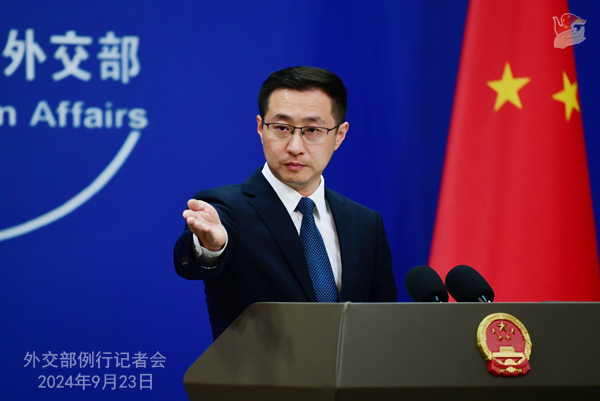Biden meets Vietnam’s president in New York
U.S. President Joe Biden and his Vietnamese counterpart, To Lam, met on the sidelines of the U.N. General Assembly in New York on Wednesday, with the pair praising rapidly warming bilateral relations nearly half a century after the end of the Vietnam War. It marked the end of a whirlwind trip to New York for Lam, who in May became president – typically considered the second-most powerful office in Vietnam – and then ascended to the top role of general secretary of the Communist Party of Vietnam last month. Lam earlier met with U.S. business executives on Monday and delivered a concise – and mostly circumspect – inaugural speech as Vietnam’s president to the U.N. General Assembly on Tuesday. He also met with Ukrainian President Volodymyr Zelensky on Tuesday and with U.N. Secretary-General Antonio Guterres on Wednesday. Meeting at the InterContinental New York Barclay hotel three blocks from the U.N. Headquarters, Lam thanked Biden for sending condolences upon the passing of his predecessor as general secretary, Nguyen Phu Trong, who died aged 80 after 13 years in office. Vietnam’s President and ruling Communist Party Chief To Lam meets with U.S. President Joe Biden (not pictured) on the sidelines of the 79th session of the United National General Assembly (UNGA) in New York City, U.S., Sept. 25, 2024. (Elizabeth Frantz/Reuters) “Even during his lifetime, the late general secretary often spoke of you with fond memories and sincere appreciation,” Lam said to Biden in his remarks in front of reporters prior to the closed-door meeting. “His historic visit to the U.S. in 2015 followed by your visit to Vietnam in September last year were historic milestones,” he added, “and have significantly advanced the growth of the Vietnam-U.S. relations, resulting in the higher level of the relations that we enjoy today.” “We appreciate very much your fondness for Vietnam, and your historic contributions have been pivotal in elevating our bilateral relations.” ‘Unprecedented cooperation’ Reading from notes, Biden noted that he and Vietnam’s leadership elevated bilateral ties to the “highest level possible” during his trip to Hanoi last year, which commentators at the time said was driven by the countries’ mutual distrust of Beijing’s growing power. “Since then, we’ve been very proud of the progress we’ve made,” Biden said, pointing to U.S. investments in microchips and supply chains in Vietnam and the countries’ “unprecedented cooperation” on cybersecurity as areas where the relationship was blossoming. U.S. President Joe Biden meets with Vietnam’s President and ruling Communist Party Chief To Lam (not pictured) on the sidelines of the 79th session of the United National General Assembly (UNGA) in New York City, U.S., Sept. 25, 2024. (Elizabeth Frantz/Reuters) Neither leader directly mentioned China in their remarks, with the Vietnamese government seeking to carefully balance its growing ties with America with productive relations with its northern neighbor. However, Biden said Hanoi and Washington were united in efforts to build “a more open and secure Indian Ocean, committed to freedom of navigation and the rule of law” – an apparent gaffe meant to refer to the Indo-Pacific region, which U.S. officials use for the vast region stretching from India through the Pacific to America’s west coast. “We continue our path breaking work to heal the wounds of war,” he added. “There’s nothing beyond our capacity to work together.” A senior administration official who spoke to reporters on condition of anonymity after the talks said it was “an extremely warm meeting” and that the pair had also discussed “stability in the South China Sea.” Earlier on Wednesday, Lam met with Guterres, the U.N. secretary general, and discussed “the importance of multilateralism, the work of the U.N., international law including the Convention on the Law of the Sea,” according to a readout released by the United Nations. Vietnamese Foreign Minister Bui Thanh Son also met with his Laotian and Cambodian counterparts, Saleumxay Kommasith and Sok Chenda Sophea, to affirm continuing cooperation in the wake of Cambodia’s recent decision to withdraw from a three-country development pact. US business leaders Lam was not only in New York for diplomatic meetings, though. His meeting with U.S. executives at a forum on the sidelines of the U.N. General Assembly on Monday was a productive one, according to Vietnamese state media, which reported that numerous cooperation deals were signed by Vietnamese and American businesses. Vietnam’s President To Lam addresses the 79th United Nations General Assembly at U.N. headquarters in New York, 24, 2024. (Eduardo Munoz/Reuters) Former British Deputy Prime Minister Nick Clegg, who is now the president of global affairs for Facebook parent company Meta, told Lam during their talks that the company planned to manufacture its Metaverse virtual reality glasses in Vietnam, the reports said. A separate meeting with Nick Ammann, Apple’s vice president in charge of global government affairs, produced an agreement to create an Apple research and development center at the National Innovation Center in Hanoi, including scholarships for Vietnamese students to study artificial intelligence and “the internet of things.” Vietnamese tycoon Nguyen Thi Phuong Thao’s Vietjet Group also signed a $1.1 billion cooperation agreement with Maryland-based Honeywell Aerospace Technologies to provide avionics and aviation technical services for Vietjet’s aircraft fleet, the reports said. Deals on liquid natural gas and data center development were also signed during the forum, according to the state media reports. After five days in New York, Lam is scheduled to fly to Cuba on Wednesday night for meetings with his country’s old communist allies in Havana. He is scheduled to return to Vietnam on Friday. We are : Investigative Journalism Reportika Investigative Reports Daily Reports Interviews Surveys Reportika


